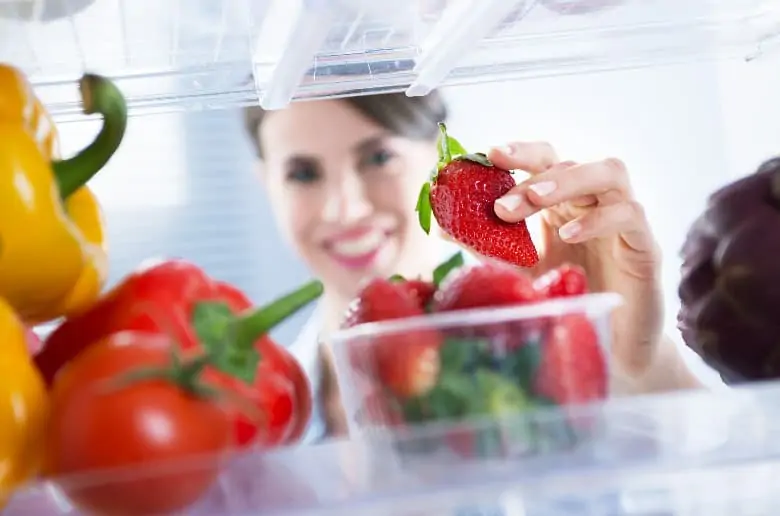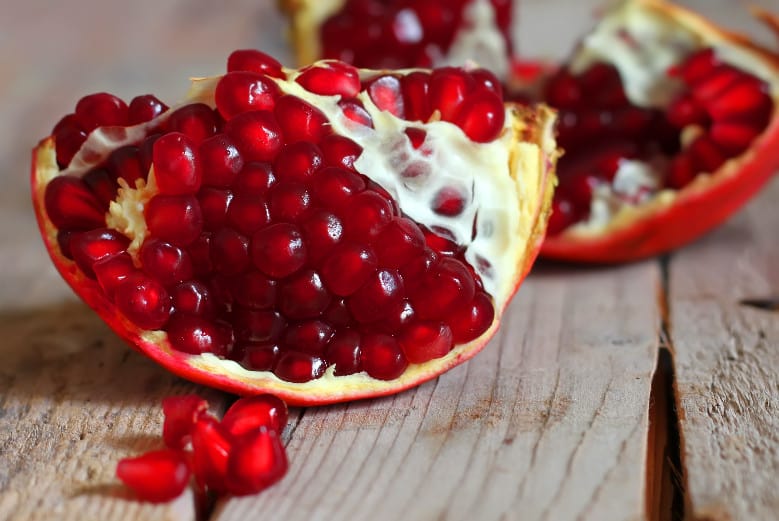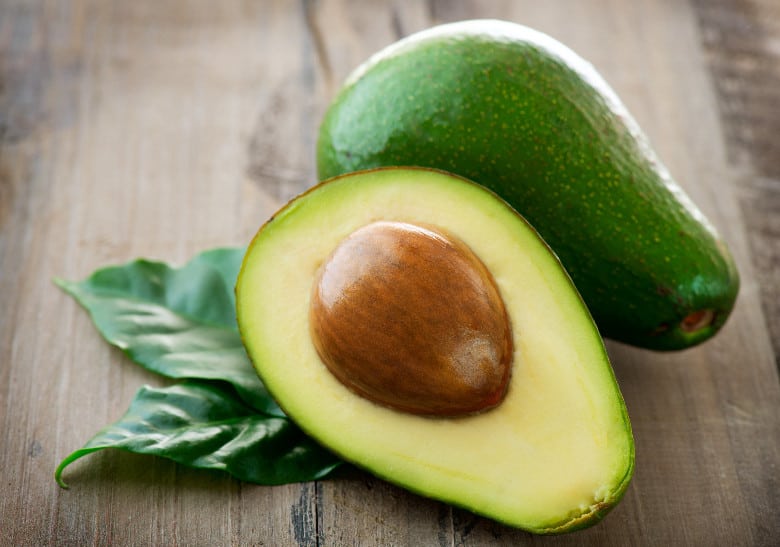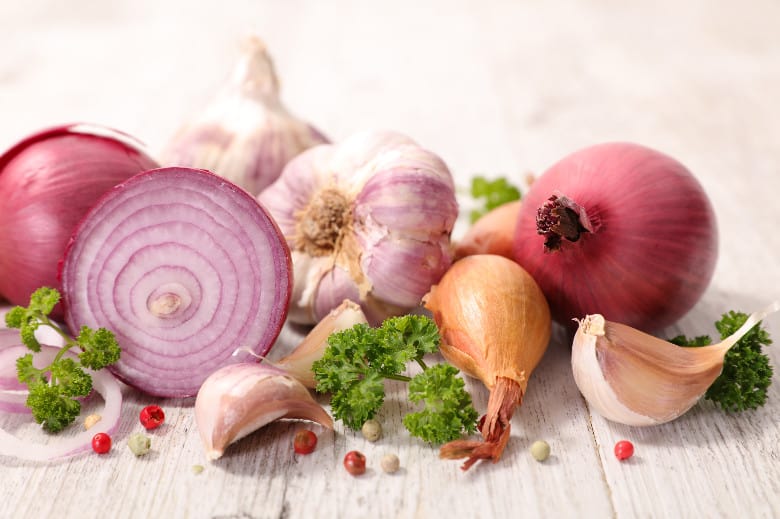Over the years of swapping kitchen tips, I’ve come across a common problem. Most people aren’t storing their produce properly.
The majority of people I talk to think the fridge is every fruit and veggie’s best friend. Big mistake. The fridge can be the culprit of lackluster produce and food waste.
For instance, have you ever pulled mushy onions or browned potatoes out of the crisper? That’s right, the fridge did it.
If you want to optimize produce shelf life, you need to pay special attention to air circulation, temperature, and ethylene gas. With the right combo, you can get the most out of your food.
Here I’ll walk you through how to store fruits and vegetables, the right way. This list of proper storage techniques will show you how.
Related: How To Organize Your Kitchen Like A Pro
Keep It In The Fridge
Let’s face it, sometimes produce habitually gets tossed in the fridge. I know, I’m guilty of this too. However, this can result in unappealing wilted greens and flimsy celery. Which, quite frankly, is a waste of money.
From crisp apples to tender greens, here are the best ways to keep certain fruits and veggies in the fridge.

Apples
When you think of a fruit bowl resting on the kitchen counter, what comes to mind? For me, it’s apples. While this may look pretty, it’s not the ideal spot.
Picked apples belong in the fridge. Leave them out in the heat and you’ll wind up with some mealy Pink Ladies on your hands.
You could place them in the crisper, but anywhere in the refrigerator will do the trick. I just recommend not shoving them to the way back where they may freeze.
Oh, and a quick word to the wise. Apples emit high ethylene gas. So you don’t want to store them near ethylene sensitive produce like potatoes.
Asparagus
I get so disappointed when I pay for a fresh bunch of asparagus only to find the stalks have gone bad. Asparagus is best used right away. I like to keep it simple and grill them with a little bit of oil, lemon, garlic salt, and pepper.
Alternatively, asparagus will keep for a few days in the fridge. Place the bottom of the stalks in a mason jar with an inch or two of water and a plastic bag on top. Carefully choose a spot in the fridge where you can keep them upright.
Berries
My grandparents used to keep a giant bowl of strawberries smack dab in the front of the fridge every time I came to visit. Partly so I could gobble them up easier. And partly because this is where berries keep best.
You want to keep berries in the warmer part of the fridge. The back tends to get too cold for them.
According to Cook’s Illustrated, washing berries in a vinegar solution before storing them enhances their shelf life. You’ll also want to keep them in a paper towel-lined container to make sure they stay dry.
Broccoli
The best home for this cruciferous vegetable is in the crisper. Just keep it away from high ethylene fruits and veggies. You can also place a damp paper towel on top so it stays crisp.
Cabbage
The thing I love about cabbage is how long it keeps. I tend to always have a head of red cabbage on hand to add to a curry chickpea salad or fresh avocado summer rolls. I also love omitting noodles and making a green cabbage pad thai when I need a boost of veggies.
The trouble is a whole head of cabbage tends to dominate the crisper drawer. If you don’t have room, you can keep it elsewhere in the refrigerator. Also, store it in a resealable plastic bag if you don’t use it all at once.
Cauliflower
Despite being in the same family, cauliflower tends to brown more easily than broccoli.
Keep it in a plastic bag. Also, don’t start plucking off florets until you’re ready to use the whole head. Follow these two tips and your cauliflower should keep up to a week.
Celery
The best way to preserve the crispy crunch of celery is to wrap it in aluminum foil and place it in the crisper.
I know, this sounds crazy. However, if you wrap a head of celery in aluminum foil you’ll lock in moisture while letting the ethylene gas escape. This does wonders to keep celery nice and crisp.
Corn
To shuck, or not to shuck. That is the question. And the answer is, don’t.
The husk helps the ears of corn retain moisture. If you happen to purchase already shucked corn, you’ll want to keep it wrapped in plastic and eat it within a couple of days.
No matter which one you buy, keep corn in the refrigerator until you’re ready to slather it in some butter and toss it on the grill.
Ginger
A warming bowl of ramen, carrot ginger dressing, braised ginger, and garlicky bok choy. . . there are so many great reasons to keep ginger on hand. However, it can be hard to keep fresh.
To preserve your ginger root, place it in a sealed container. If you don’t have a small enough container, you could use a paper bag and store it in the crisper. Also, leave the skin on until ready to use.
Head Lettuce
Head lettuce like iceberg or red lettuce store differently than their tender leafy green cousins. This is because they are less delicate. That said, you still want to pay attention to how you store them.
The best way is to use the crisper. Be sure to place them in a plastic bag first. You’ll want to avoid excess moisture so don’t wash them until you’re ready to eat.
Herbs
Fresh herbs are very delicate. Carelessly place them in the refrigerator and you’ll find out the hard way.

Place fresh herb bundles, such as cilantro and Italian parsley, in a dry paper towel. Then stash them in a resealable plastic bag and put them in the crisper.
If you’re worried about them getting smashed, you could fill a jar with a couple of inches of water and place the bunch stem down. Like asparagus, you’ll want to place a plastic bag on top.
Lemons and Limes
Did you know you can increase the shelf life of lemons and limes by placing them in the fridge? Make sure they’re dry first and use a resealable bag.
When ready to squeeze, leave them out at room temperature. You can get more juice out of room temp lemons and limes than cold ones.
Mushrooms
Mushrooms are one of those vegetables (fungus, if you want to get technical) that can get moldy fast. Enhance their shelf life by storing them in a paper bag or the container they come in. Place them in the fridge and don’t wash until ready to use.
Keep in mind, even with proper storage mushrooms should be used within five days. I recommend dipping them in hummus or stuffing them with blue cheese as a quick snack.
Tender Leafy Greens
There’s nothing I hate more than craving a big leafy green salad only to find they’ve turned into a ball of brown slim. And I have a feeling you’ve been there too.
Greens are stored best unwashed in a plastic bag or container. Too much moisture will cause tender greens like spring mix to go bad fast.
Note you can wash your greens ahead of time. Just be sure to remove any excess moisture. I like to pat them dry (a salad spinner will work as well) and wrap them in a paper towel. This typically will keep for a few days before that dreaded browning begins.
If you do buy greens in a bag or container, sort through them first. Toss anything that is wilted or brown to keep the rest of your greens fresh.
Store It On the Countertop
Fresh produce that likes room temperature is best kept on your kitchen countertop. However, you’ll want to make sure all those goods get proper airflow. That’s why I rely on baskets.
Produce baskets allow air to circulate better than cramming everything into an oversized fruit bowl. You can also hang them to allow for more food prep space.
Whatever you do, don’t store produce near the stove. The heat emitted from the stove can alter how well your produce keeps.
Basil
Storing fresh basil is tricky. Unlike bunched herbs, basil doesn’t store well in the fridge. Keep it out at room temperature so the leaves remain crisp.
From sandwiches to pasta, it’s not hard to find an excuse to buy fresh basil. It’s a must for Caprese salad and phenomenal on pizza.
Citrus fruit
Grapefruit, navel oranges and other citrus fruits do just fine at room temperature. Their hard peels naturally preserve the fleshy fruit inside. You can place them in the fridge if you like, but it’s not necessary.
Pomegranates
Ever wonder the best way to store pomegranates? Right on your counter.

Whole pomegranates store well at room temperature. It’s once you pluck out all those delicious seeds that they need to be placed in an airtight container and kept in the fridge.
Try them in a grain salad with some creamy avocado and farro. They also taste great in numerous holiday dishes that need a juicy burst of flavor.
Tomatoes
Few things can beat biting into a fresh, ripe garden-grown tomato. To preserve their juicy and firm texture, avoid the refrigerator.
Refrigerated tomatoes turn mushy. This isn’t exactly ideal for a loaded veggie sandwich or towering burger. Leave tomatoes out at room temperature and avoid direct sunlight.
Transition From Counter to Fridge
Ok, here’s where things get confusing. Some fruits and veggies do better in the fridge. Some do better on the countertop. And some do better with a combination of both.
The ones that do better with both typically are climacteric. These are your avocados, mangoes, and other produce that’s picked before ripening.
Bananas
Some people may like overly ripened bananas. I am not one of those people.
Whenever I buy bananas, I’m careful not to let them over ripen. The way to do that is to buy them while they’re still slightly green. Then once they ripen you can place them in the refrigerator.
But not near other ethylene sensitive produce! The reason bananas turn brown so fast in a hot car is because of ethylene gas. Ethylene speeds up the ripening process which is further exacerbated by heat. So please, keep these away from your cubed butternut squash.
Avocados
Marrying a former avocado farmer came with some perks. And yes, free avocados is one. But what I’m getting at here is learning about proper storage.
Like many fruits and veggies, avocados are typically picked before ripening. When you bring hard avocados home from the store you should leave them out at room temperature.

Once they begin to soften you need to place them in the fridge immediately. Also, avocados do better if you allow for proper air circulation. Opt for a fruit basket rather than a fruit bowl.
Mangoes
Juicy mango slices are a refreshing treat on a sweltering summer day. Sprinkle on some chili powder with a twist of lime and you’ve really got a treat.
To avoid overripening, place them in the fridge once they reach their peak. Alternatively, to speed up the process you can stick them in a brown paper bag.
Melons
Watermelon, cantaloupe, and honeydew are all best kept on the counter. As soon as they ripen, I recommend eating them.
Alternatively, you can place them in the fridge. However, they tend to take up a good deal of space so I would use them sooner rather than later.
Pineapple
There are so many uses for fresh pineapple. One of my favorites is to skewer them with bell peppers, tomatoes, red onion, and salmon then toss them on the grill. If you’re feeling fancy, you can serve your guests fruit salads in pineapple boats or add them as a garnish to tropical cocktails.
Whichever recipe you choose, you’ll want to store pineapple whole on the kitchen counter. Once ripened, transfer it to the fridge.
Find A Cool, Dark Place
Pantries and root cellars are an excellent cool and dark place for stashing numerous vegetables. While kitchen cabinets are also dark, I’d be careful.
Your cool, dark-loving produce needs proper airflow. They also need to remain cool (typically 50-70°F) which can be very difficult in a kitchen cupboard.
Designate a specific spot for your cool, dark-loving veggies. But don’t forget to check in on them from time to time! You’ll need to toss anything that’s started to go bad.
Garlic, Onions, and Shallots
Alliums such as garlic, onions, and shallots should be kept in your pantry or a cool place with low humidity. Moisture will cause them to spoil faster.

Never, I repeat, never, store them in a plastic bag. Plastic is more likely to suffocate them and these babies need to breathe! They should also be stored in the dark so they don’t begin to sprout.
Fear not, however, if they do sprout. Unlike potatoes, you can still eat them if they start to turn green.
Potatoes
Have you ever pulled out a sack of potatoes just to find your spuds have started to look like a science experiment?
Unfortunately, this is inevitable. However, you can slow down spoilage by storing potatoes in a humid environment that’s dark and cool. Wherever this spot may be, be sure it includes proper airflow.
Whatever you do, don’t store potatoes next to onions or garlic! Ethylene emitted from garlic and onions will cause potatoes to go bad.
Winter Squash
I always keep a couple of butternut and spaghetti squashes on hand once the weather turns brisk. Winter squashes such as these are great for hearty stews and keep exceptionally well. I’ve had some that lasted up to six months.
The key is to store winter squash in a cool room away from direct light. Ideally, individually lined out on a wire rack. This will allow for proper airflow and keep them good for months to come.
Not All Produce Play Well Together
It’s not enough to store your fruits and veggies in the right temperature and lighting conditions. It turns out they also are picky about who they hang out with. This is because of something called ethylene. When most fruits and vegetables begin to ripen they give off ethylene gas. Some give off more of the gas than others, and some are more sensitive to the gas than others which can speed up the ripening process. Unless you are intentionally trying to speed things up, it’s important to keep the high ethylene producers and the ethylene-sensitive items separated.
Some Common High Ethylene Producers
- Apples
- Avocadoes
- Bananas
- Cantaloupe
- Onions
- Pears
- Peppers
- Tomatoes
Some Common Ethylene Sensitive Fruits and Veggies
- Asparagus
- Broccoli
- Cucumber
- Cabbage
- Lettuce
- Potatoes
- Spinach
Fruit and Veggie Storage Tips
- Cut the greens off root veggies before storing
- Don’t wash produce until ready to use
- Keep greens in their original packaging
- Never store high ethylene gas produce (like garlic and onions) with ethylene sensitive produce (like broccoli)
- Produce baskets can help with air circulation
- When in doubt, store your produce dry
- Wash berries with a vinegar solution before storing
- Toss out green potatoes
- Green alliums are still ok to eat
- Don’t store apples with bananas
Conclusion
Finding the best way to store fruits and veggies all has to do with the right temperature and proper air circulation. Additionally, high ethylene produce can cause ethylene sensitive produce to spoil faster.
And remember, the best time to wash produce is typically right before you eat it. If you do wash to save time, make sure everything is fully dry.
